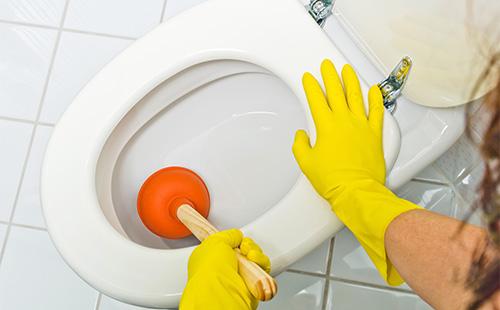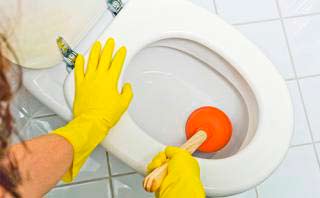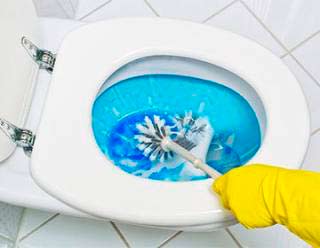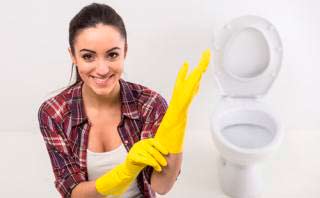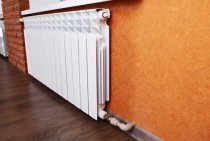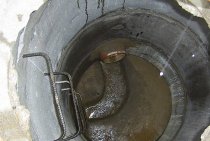Mechanical cleaning methods
If it is not possible to clean the blockage in the toilet with the help of folk or chemical means, then you can resort to mechanical cleaning. The procedure is carried out manually or using such "assistants" as a plunger and a plumbing cable.
hands
What to do if the toilet is clogged with foreign objects: toys, rags, large food cleaners? Before removing the blockage in the toilet, it is necessary to examine the emergency area manually. Putting gloves on your hands, follow four steps in sequence.
Scooping water out of the toilet.
They lower their hand into the drain and try to feel for a foreign object.
Grab soft clogs with your fingers and gently pull them out of the toilet.
Further and denser objects are pulled out with a wire with a hook at the end.
Sometimes, after unsuccessful attempts to pull an object out of the toilet, the owners decide to push it. Such actions drive the cork much deeper and only exacerbate the problem.
plunger
When the cause of the blockage has not been identified, and water is still able to seep, it is recommended to use a plunger to clean the toilet. The effectiveness of cleansing depends on the right "helper". On sale you can find several varieties of plungers.
- Cup-shaped. This is a simple model. It is designed to eliminate small congestion. A bowl-shaped plunger will help clean the sink. But in the case of congestion in the toilet, this remedy is ineffective.
- Taper. This model is able to eliminate the blockage in the toilet. A dense rubber nozzle with a conical shape ensures the correct entry into the drain hole.
- Pneumatic. The most advanced model with great power. The plunger is equipped with a nozzle that can "maneuver" inside the pipe.
The procedure for cleaning the toilet with a plunger is quite simple and includes the following three steps.
- A rubber nozzle is placed on the drain hole so that the plunger completely covers it.
- To pump out, make a few light pressures (the rubber suction cup should “adhere” to the hole).
- At this moment, they sharply pull the handle, and tear off the nozzle from the drain hole.
Water hammer with this technique provides cleaning from the cork formed by newsprint, fine cleanings or other rubbish.
plastic bottle
How can you pierce the toilet without a plunger at home? If the necessary device is not on the farm, then you can try to create hydraulics using an ordinary plastic bottle. The purification process is carried out in four stages.
- The bottom of the bottle is carefully cut off.
- Screw the lid on tightly for the rest.
- A plastic bottle with the cut side is placed on the drain hole.
- Holding on to the top with the cover, try to create a water hammer as if using a plunger.
Plumbing cable
Such an event is used in the most extreme cases, when none of the above methods can remove the cork. The help of a plumbing cable is resorted to in case of clogging of the sewer with construction waste (sand, clay, putty), cat litter. The auger (cable) is a flexible steel "snake", with which you can reach the most inaccessible sections of the sewer. It is equipped with a special handle that provides rotation of the cable. To clean the toilet, seven steps are sequentially performed.
The plumbing cable is lowered into the drain hole.
Slowly advance the cable along the bends of the toilet.
The cable is carefully turned so that it passes freely through the pipes.
When the auger rests, they begin to rotate it, winding up the garbage.
The cable with the hooked "weight" is carefully pulled out of the toilet.
After cleaning the auger, it is re-launched into the sewer pipe.
Repeat until the blockage is completely eliminated.
Cleaning the toilet at home is easy. But it is hardly possible to call this procedure pleasant. In order not to resort to the need to clean the toilet, experienced owners recommend prophylaxis. To do this, from time to time it is necessary to clean the toilet with baking soda and vinegar. In this case, plaque and dirt will not accumulate, and the toilet will always be snow-white and fresh.
Cleaning methods
There are several effective ways to wipe off pollution:
- Bring the vinegar to forty degrees, then pour baking soda into it, mix well. Apply the resulting gruel to the dirt and leave it there for ten hours. Clean up at night.
- Citric acid has long been successfully used by many housewives to successfully clean their toilets and bathrooms. Take a couple of sachets of this acid, sprinkle the contaminated areas. Make sure that the citric acid covers the dirt completely. After two hours, wash and rinse the toilet bowl with plenty of hot water.
- Sprinkle ethanedioic acid on urinary stone and limescale. Wait two hours. Then you need to wash the toilet with warm water.
- Flush all the water out of the toilet. Then throw a few liters of Coca-Cola into it. Leave sweet water to sleep in your toilet bowl. Just do not immediately drain the water! This will have to be done in the morning. Then, at the same time, wash the walls of the toilet bowl with a brush.
- A simple baking soda will help you remove the limescale. Take a pack of soda, pour it into the toilet and leave it for 30 minutes. Then pour table vinegar into it. You will see a chemical reaction between substances. Then scrub the toilet with a brush.
Tips & Tricks
In order not to face every day with the problem of getting rid of urinary stone, limescale, unpleasant smell in the toilet, you need to monitor its cleanliness. Remove all deposits in the drain tank. This procedure should be carried out at least once every six months.
Here are some tips to help you keep your toilet clean:
- Use cleaning gels that have bleaching and disinfecting properties.
- Wash the toilet not only from the inside, but also from the outside. To clean the toilet, use a special brush. Keep your toilet brush perfectly clean. As it gets dirty, buy a new one from the store.
- You can easily clean the toilet in hard to reach places with your old toothbrush. The lid and seat of the toilet are wiped with paper napkins or a piece of dry toilet paper.
- Fill the neck of the toilet with a special washing gel and leave it there for half an hour. You need to do this in order to get rid of all the dirt. Then scrub the dirt with a toilet brush. Clean the drain with a special gel. Always wear rubber gloves, this will protect the skin of your hands.
- For external cleaning of the toilet, use napkins or paper towels. Pour the required amount of disinfectant, soak a towel and wipe the sides of your toilet.
The tank may be coated. This can impair the condition of the drain and the functionality of your toilet. Rust appears in the form of untidy red stripes, and pieces of lime violate the tightness of the valve, due to which the tank begins to leak. To clean the inside of the tank, remove the lid from it.
The products that are used to clean toilet bowls will help you rid the tank of various dirt: gels, table vinegar, ethanedioic acid, Coca-Cola, and a variety of pipe cleaners. Drain the water. Pour a special gel on the bottom of your tank, wait until the tank is filled with water, and leave for ten hours.
Using a washcloth, apply a special agent (liquid, powder, gel, a mixture of vinegar and baking soda) to the walls, bottom, drain parts and wait a while. Then wash the tank with warm water, empty it and refill the tank.
For ease of care in the toilet, you can always keep a pack of wet wipes. Clean and wipe down your toilet every day. By devoting enough time and effort to this work, you will no longer encounter the problem of deposits, limescale and rust.
For more tips on how to clean the toilet from limescale and urinary stone, see the following video.
Folk remedies to help
How to clear a blockage in the toilet? If no one threw any foreign objects into the toilet, then ordinary home remedies can come to the rescue. They will be invaluable in the formation of rust congestion, urinary stone, fatty deposits and plaque. The most common and effective folk remedies:
Lemon acid. It qualitatively removes urinary stone and plaque on the pipes. It is recommended to pour three tablespoons of citric acid into the toilet. In this state, the plumbing is left for three to four hours. Then the closet is cleaned with a brush and the water is drained. A nice bonus of such an event will be the freshness in the toilet room.
Soda. If possible, flush the water from the toilet. Then soda is poured into it. It will take about 250 g (half a pack). In this form, the plumbing is left all night (at least eight hours)
Then carefully drain the water, if necessary, help with a brush. Cleaning with soda will help not only eliminate plaque, but also whiten the toilet bowl with high quality.
Vinegar
To get rid of congestion, you need a 9% product. A liter of vinegar must be heated. Warm liquid is poured into the toilet, having previously scooped up water and left for three to four hours. With a rough sponge or brush, carefully clean the accessible surface. Then carefully wash off with water.
Vinegar soda. If individually these products did not bring the desired result, then you can try to eliminate the congestion with a combination of baking soda and vinegar. Water from the toilet must be exhausted. Pour 250 g of soda into the drain. Then pour a glass of vinegar into it. Get ready for a hiss. After 15 minutes, when the "boiling" of soda is over, pour half a liter of very hot water into the toilet. But remember that you can not use boiling water, otherwise the porcelain toilet may not withstand the temperature drop. This remedy will get rid of plaque and remove the fatty plug if food residues are often poured into the toilet bowl.
Hydrochloric acid. It acts very aggressively, so it is used only in extreme cases. But it is hydrochloric acid that is able to dissolve the congestion formed by cat litter. It is necessary to pour a little liquid into the toilet bowl and leave for one hour. Then you can try to wash off the water. But if the sewer pipes are made of plastic, then hydrochloric acid is prohibited. She'll eat the pipes.
Mechanical cleaning methods
If it is not possible to clean the blockage in the toilet with the help of folk or chemical means, then you can resort to mechanical cleaning. The procedure is carried out manually or using such "assistants" as a plunger and a plumbing cable.
hands
What to do if the toilet is clogged with foreign objects: toys, rags, large food residues? Before removing the blockage in the toilet, it is necessary to examine the emergency area manually. Putting gloves on your hands, follow four steps in sequence.
Scooping water out of the toilet.
They lower their hand into the drain and try to feel for a foreign object.
Grab soft clogs with your fingers and carefully remove from the toilet.
More dense objects are located further and removed with a wire with a hook at the end.
plunger
When the cause of the blockage has not been found, and water is still able to seep, it is recommended to use a plunger to clean the toilet. The effectiveness of cleaning depends on the right "helper".
On sale you can find several varieties of plungers.
- Chashopodibny. This is a simple model. It is designed to eliminate small congestion. A bowl-shaped plunger will help clean the sink. But in the case of congestion in the toilet, this remedy is ineffective.
- Taper. This model is able to eliminate the blockage in the toilet. A dense rubber nozzle, has a conical shape, ensures the correct entry into the drain hole.
- Pneumatic. The most advanced model, has great power. The plunger is equipped with a nozzle that is able to "maneuver" inside the pipe.
The procedure for cleaning the toilet with a plunger is quite simple and includes the following three steps.
- A rubber nozzle is placed on the drain hole so that the plunger completely covers it.
- To pump out, make a few light pressures (the rubber suction cup should “grab” the hole).
- At this moment, they sharply pull the handle, and tear off the nozzle from the drain hole.
The water hammer in this technique ensures that the plug created by newsprint, small food residues or other debris is cleared.
plastic bottle
How can you pierce the toilet without a plunger at home? If the necessary device is not on the farm, then you can try to create hydraulics using an ordinary plastic bottle. The purification process is carried out in four stages.
- Carefully cut off the bottom of the bottle.
- Screw the lid on tightly for the rest.
- A plastic bottle with the cut side is placed on the drain hole.
- Holding on to the top with the cover, try to create a water hammer as if using a plunger.
Plumbing cable
Such a measure is used in extreme cases, when the cork cannot be removed by the above methods. The help of a plumbing cable is resorted to in case of clogging of the sewer with construction waste (sand, clay, putty), cat litter. The auger (cable) is a flexible steel "snake", with which you can reach the most inaccessible sections of the sewer. It is equipped with a special handle that ensures the rotation of the cable. To clean the toilet, seven steps are sequentially performed.
Types of pollution
The main problem that people face in their bathrooms and toilets is the yellowness of plumbing and its sloppy appearance. It also forms ugly smudges of dirt, a crust of limescale, traces of corrosion and biological contaminants.
Long-term operation of the toilet bowl entails the formation of limescale and urinary stone, which are extremely difficult to remove. Therefore, in the arsenal of the fight against urinary stone, you should always keep several effective ways to remove such contaminants.
Fortunately, modern plumbing pleases its consumers with new technologies, becoming ergonomic, aesthetic and simple. Not so long ago, the plumbing market was conquered by "smart plumbing" with an infrared sensor and auto flush. But unfortunately, even these innovations are not immune to problems with pollution and stone formation.
Limescale, like stone, is associated with exploitation and does not manifest itself immediately. Only after a long time, unaesthetic plaque becomes noticeable under the rim of the toilet bowl and in the places where the water is drained
Therefore, it is important to clean the toilet bowl as often as possible, this will save you from years of accumulation of plaque, and the removal of urinary stone will not be so problematic.
Urinary stone accumulates over the entire surface of the toilet due to the deposition of salts. Over time, it becomes impossible to clean it with a regular brush or brush. Limescale on the walls of the toilet bowl, an unpleasant smell - a consequence of the rare cleaning of the toilet bowl and its unsanitary conditions.Therefore, in order to avoid unnecessary expenses and keep plumbing clean, you should first get rid of deep problems:
- Eliminate all leaks from the drain tank. To avoid overfilling the tank, you just need to adjust the float. And in some cases, a complete replacement of the tank with a new one is also necessary.
- Adding water softener tablets to the drain tank will help to avoid further problems with odor and urinary stone.
- At least once a week it is necessary to clean the toilet bowl with an antibacterial agent. It will be enough to apply it on the walls of the toilet, brush a little and rinse with water.
Some owners prefer not to wage a "war" with such problems and decide to purchase a new toilet. But fortunately, there are many ways that will allow you to easily remove raids and save the family budget. Each method of cleaning the toilet should correspond to the degree of its contamination.
How to clean the toilet from blockage 4 recommendations
There are many reasons that can lead to sewer clogging. This may be the improper operation of the toilet: the release of garbage into it, waste after repairs or cat litter. But sometimes the sewer is clogged even without the "help" of the owners. Neighbors can also contribute. And sometimes clogging occurs due to poor-quality, too hard water, which ensures the gradual deposition of plaque on the pipes. Then there is an urgent need to figure out how to clean the toilet yourself if it is clogged.
Before analyzing effective sewer cleaning methods, it is necessary to dwell on four tips from the masters.
- Find out the cause of the blockage. Solving the problem must begin with asking all family members about the possible source of the problem. For example, a child may accidentally drop a toy into the toilet. In this case, half of the effective methods will be ineffective. To cope with such a congestion, if the object is far enough away, only a cable will help.
- Determine the location of the plug. If the water does not come out well in the toilet, do the novice owners immediately decide? They assume that the blockage arose in the toilet pipe and use all available methods to clean it. This approach is not entirely correct. After all, the congestion could have arisen much further, in the sewer pipe. To roughly determine the location of the cork, you need to open the taps in the bathroom and in the kitchen. If the water drains normally and does not linger in the pipe, then the problem is really in the toilet plexus. But if the water quickly filled the pipe and very slowly flows out of the sink, then the problem is quite serious, and it is better to use the services of a plumber.
- Do not use a tank. To check how the water is flowing or to clean the pipes "under pressure", do not use the drain tank. If the blockage in the toilet is too strong, then all the water mixed with sewage can pour out through the toilet directly onto the floor. Another unpleasant phenomenon is also possible. Bath and toilet are two communicating vessels. Therefore, dirty water, which cannot eliminate the blockage, has only one thing to do - flood the bathroom. It is better to pour water from the basin, strictly controlling the process of its outflow.
- Urgently call a plumber. In some situations, even knowing how to clean the toilet if it is clogged, it will not be possible to achieve a positive result. If, upon opening the toilet, you notice that the water level is gradually rising, this means that a blockage has formed in the common riser. In this case, your toilet and sewer riser will become the communicating vessels. Do I need to say that very soon all the sewage will overflow and fill the toilet? No cleaning action will help solve the problem. Only a plumber can handle this plug, using special inspection hatches and a plumbing cable.
Folk remedies to help. toilet cleaning
How to clear a blockage in the toilet? If no one threw any foreign objects into the toilet, then ordinary home remedies can come to the rescue. They will be of inestimable benefit in the formation of congestion from rust, urinary stone, fatty deposits and plaque. The most common and effective such folk remedies.
Lemon acid. It qualitatively eliminates urinary stone and plaque on the pipes. It is recommended to pour three tablespoons of citric acid into the toilet. In this state, the plumbing is left for three to four hours. Then the closet is cleaned with a brush and the water is drained. A nice bonus of such an event will be the freshness in the toilet room.
Soda. If possible, flush water from the toilet. Then soda is poured into it. It will take about 250 g (half a pack). In this form, the plumbing is left all night (at least eight hours)
Then carefully drain the water, if necessary, help with a brush. Cleansing with soda will help not only eliminate plaque, but also whiten the toilet bowl with high quality.
Vinegar
To get rid of congestion, you need a 9% product. A liter of vinegar must be heated. Warm liquid is poured into the toilet, with previously scooped up water, and left for three to four hours. With a rough sponge or brush, carefully clean the accessible surface. Then carefully wash off with water.
Vinegar soda. If individually these products did not bring the desired result, then you can try to eliminate the congestion with a combination of baking soda and vinegar. Water from the toilet must be scooped out. Pour 250 g of soda into the drain. Then pour a glass of vinegar into it. Get ready to sizzle. After 15 minutes, when the “perturbations” of soda are over, pour half a liter of very hot water into the toilet. But remember that you can not use boiling water, otherwise the porcelain toilet may not withstand temperature changes. This remedy will get rid of plaque and eliminate the fatty plug if food residues are often poured into the toilet bowl.
Hydrochloric acid. It acts very aggressively, so it is used only in extreme cases. But it is hydrochloric acid that is able to dissolve the congestion formed by cat litter. It is necessary to pour some liquid into the toilet bowl and leave it for one hour. Then you can try to wash off the water. But if the sewer pipes are made of plastic, then hydrochloric acid is prohibited. She'll eat the pipes.
There are tips to use such improvised means as whiteness, Coca-Cola, bleach. They are ineffective and can only deal with small traffic jams. But as a bleach for the toilet is very useful.
How to clean a clogged toilet bowl 4 recommendations
There are many reasons that can lead to sewer clogging. This may be improper use of the toilet: throwing garbage into it, waste after repairs or cat litter. But sometimes the sewer is clogged even without the "help" of the owners. Neighbors can also contribute. And sometimes a blockage occurs due to poor-quality, too hard water, which ensures the gradual deposition of plaque on the pipes. Then there is an urgent need to figure out how to clean the toilet yourself if it is clogged. Before analyzing effective methods for cleaning sewers, it is necessary to dwell on four tips from the masters.
- Find out the cause of the blockage. Solving the problem must begin with asking all family members about the possible source of the problem. For example, a child may accidentally drop a toy into the toilet. In this case, half of the effective methods will be ineffective. To cope with such a congestion, if the object is far enough away, only a cable will help.
- Determine the location of the plug. If the water does not go well in the toilet, what do the newcomers immediately decide? They assume that the blockage arose precisely in the toilet pipe and use all available methods to clean it. This approach is not entirely correct.After all, the congestion could have arisen much further, in the sewer pipe. To approximately determine the location of the cork, it is necessary to open the taps in the bathroom and in the kitchen. If the water drains normally and does not linger in the pipe, then the problem is really in the toilet plexus. But if the water quickly filled the pipe and leaves the sink very slowly, then the problem is quite serious, and it is better to use the services of a plumber.
- Do not use a tank. To check how the water is leaving or to clean the pipes “under pressure”, do not use the drain tank. If the blockage in the toilet is too strong, then all the water mixed with sewage can pour out through the toilet directly onto the floor. Another unpleasant phenomenon is also possible. Bath and toilet are two communicating vessels. Therefore, dirty water, which is unable to eliminate the congestion, has only one thing to do - flood the bath. It is better to drain the water from the basin, strictly controlling the process of its outflow.
- Urgently call a plumber. In some situations, even knowing how to clean the toilet if it is clogged, it will not be possible to achieve a positive result. If, upon opening the toilet, you notice that the water level is gradually rising, this means that a blockage has formed in the common riser. In this case, your toilet and sewer riser will become the communicating vessels. Do I need to say that very soon all the sewage will overflow and fill the toilet? No cleansing measures will help solve the problem. Only a plumber can handle this plug, using special inspection hatches and a plumbing cable.
If the blockage occurs too often, then you need to pay attention to the toilet itself. Modern models that harmoniously complement the design of the toilet are not always suitable for installation in old sewer systems.
Therefore, when purchasing plumbing, it is important to pay attention not only to its combination with the overall interior, but also to the technical characteristics of the selected model.
Cork chemicals
Manufacturers have developed many chemical compounds that can dissolve blockages formed in pipes. Their main advantage over folk methods is the speed of exposure. Typically, effective cleaning occurs 15-20 minutes after using the selected reagent.
Such products can be used to clean the toilet from blockage.
- "Mole". A budget tool that can effectively clean pipes. It contains caustic soda and surfactant components. This combination ensures the dissolution of fats, solid waste, such as fish scales, hair. Produce "Mole" in the form of powder and gel. The agent can be used for steel and cast iron pipes. But for plastic counterparts, some types of "Mole" are strictly prohibited.
- Vortex Draft. This product is available in liquid form. Effective dissolution of plugs is provided by active chlorine, caustic soda and surfactant components. The drug is able to cope with severe biological intake and fat accumulation. Can be applied to any pipes.
- "Bagi Pothan". This is an expensive option, which ensures that even the most serious blockages are cleared. But the reagent also has a negative quality. This substance contains alkali, therefore it can worsen the condition of the pipes. Given such an aggressive action, it is not recommended to use "Bagi Pothan" for worn plumbing. And you should not resort to his help too often.
- "Mister Muscle". This product is available in powder or gel form. It has a mild effect, and you should not count on the elimination of serious congestion with its help. With minor traffic jams, "Mr. Muscle" will cope in just a couple of minutes. But if the congestion is more serious, then it is recommended to pour the product into the toilet and leave it overnight.
- "Tiret". The preparation is based on chlorine-containing bleach, surfactant and sodium hypochlorite. The tool can be used for both metal and plastic pipes.Effectively cleans from traffic jams, eliminates unpleasant odors and has a disinfecting ability.
What can be washed
Domestos or "Toilet Duck" can easily and quickly cope with ordinary pollution only if they are used regularly. To avoid the appearance of traces of a urinary stone, you should clean the toilet from yellow plaque with your own hands at least once every seven days.
Here are a few options available:
- Cleaning the toilet will help ordinary vinegar. It must be poured into water and left somewhere for 3 hours. After that, you just need to press the drain button. Such a simple and affordable method will allow you to get rid of a slight accumulation of urinary stone after the first application.
- Citric acid is another component that allows you to remove urinary stone and limescale without spending extra money and time. Two bags of citric acid are poured into the toilet and left there for 3-5 hours. After that, the product is washed off with water, and the remnants of plaque are cleaned off with a brush. If after the first cleaning the expected result is not achieved, this simple procedure should be repeated.
- "Whiteness" is far from a harmless remedy, however, it is quite effective in the fight against urinary stone. The plunger removes all the water from the knee of the toilet bowl, after which a bottle of "Whiteness" is poured out, the toilet bowl is closed with a lid and left for the whole night. In the morning, you need to wash off the product several times and evaluate the result. If desired or unsatisfactory result, repeat the procedure again.
- A 33% saline solution is used when cleaning the toilet only if the plumbing is not made of plastic. Removal of a urinary stone with acid should only be performed with protective gloves, thereby protecting the skin from a possible chemical burn. Pour the dry walls of the toilet with plenty of acid, then leave for half an hour. Before washing, clean the places of contamination with an unnecessary brush and rinse several times with clean water. The method, although quite toxic, is extremely effective.
- Electrolyte is another method that is prohibited if you have plastic pipes. However, the electrolyte is the most radical and effective in methods of cleaning the toilet from urinary stone. The electrolyte is simply poured into the toilet, left there for a couple of hours and washed off with water.
- Perhaps in every home you can find oxygen bleach, which can also be useful in getting rid of urinary stones. The agent is poured onto the urinary stone, then this place is intensively rubbed with a stiff brush and washed with clean warm water.
- Abrasive cleaners such as Domestos, Komet. Their method of application is simple, although unpleasant. All the water is scooped out of the toilet, the walls are covered with a product and rubbed with a rag or sponge until it is crystal white. The only disadvantage of this method is that the glossy surface of the toilet bowl can become rough due to the formation of scratches after cleaning with such products. And scratches, in turn, contribute to the rapid accumulation of plaque and urinary stone on the walls of the toilet.
- Dry oxalic acid is used more often in the chemical industry to clean the surface before the enamel coating procedure. But a small amount of such acid can successfully cope with the elimination of pollution in the toilet bowl. To do this, the substance is applied to a rag (the use of gloves is mandatory), with which the contaminated areas are wiped. Even easier is to pour the acid into the water, clean with a ruff and rinse with water.
- Carbonated drinks such as Cola, Sprite. Although the purpose of these drinks does not at all imply cleaning the toilets, but as practice has shown, they cope with this task quite well. Only after that it becomes scary for what these drinks can do to the human stomach. A couple bottles of sparkling water poured down the toilet.Due to the content of citric acid in the drink, plaque corrodes extremely quickly.
It must be remembered that a new and expensive toilet is much easier and more profitable to keep clean. Do not forget about prophylactic agents that can clean the drain from all kinds of raids and deposits.
How to get rid of blockage
If you notice that the toilet has become reluctant and problematic to flush even a small amount of household waste, then most likely it is simply clogged, and you risk flooding the neighbors from below. The water from the drain can rise from the inside to the rim of the toilet bowl and pour onto the floor of the toilet. The water will of course contain fecal particles, wet wads of toilet paper, etc.
What to do in such an emergency? Do not write off the conclusions and do not panic. It is not necessary to immediately contact the Housing Office. First, try to do all the dirty work yourself, for example, with the help of a good old air vent.
They used it even when no one heard about imported products like Tiret or Komet. The wad of debris was simply pushed deep into the sewers.
Nowadays, a different method is much more effective. With the help of acid, the lump of debris dissolves, and thus the blockage is eliminated. He will independently go into the sewer pipe with a water stream.
Pump out the water, but not completely. Let there be a little bit left inside. Pour half a pack of baking soda down the drain. With the help of pushes of the air vent, we push the baking soda further into the sewer and pour one glass of table vinegar into it.
Pipes tired of clogging will only be happy with such a “cocktail”. The chemical reaction takes about twenty minutes. Then you need to pour about one and a half to two liters of boiling water into the toilet drain. The result is guaranteed.
You can also remove the blockage with the help of household chemicals for cleaning various pipes, for example, it may be familiar from childhood "Mole". Foreign "Tiret Turbo", "Debucher" are also good. Sometimes, when the blockage is small, it will be enough to pour 2 liters of Coca-Cola into the drain. True, it is not always at hand.
